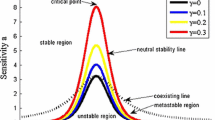Abstract
In this article, the traffic hydrodynamic model considering the driver’s reaction time was applied to the traffic analysis at the intersections on real roads. In the numerical simulation with the model, the pinch effect of the right-turning vehicles flow was found, which mainly leads to traffic jamming on the straight lane. All of the results in accordance with the empirical data confirm the applicability of this model.
Similar content being viewed by others
References
DAI Shi-qiang, FENG Su-wei, GU Guo-qing. Dynamics of traffic flow: its content, methodology and intent[J]. Nature Magazine, 1997, 19(4): 196–201(in Chinese).
DAI Shi-qiang, XUE Yu. Investigation on modeling and simulation for traffic flow[C]. Traffic and Granular Flow[C]c. Hangzhou: Zhejiang University Press, 2004, 66–125 (in Chinese).
CHOWDHURY D., SANTEN L., SCHADSCHNEIDER A. Statistical physics of vehicular traffic and some related systems[J]. Phys. Rept., 2000, 329: 199–329.
LIGHTHILL M. J., WHITHAM G. B. On kinematic waves II: A theory of traffic flow on long crowded roads[J]. Proc. Roy. Soc. Lond., 1955, A229(1178): 317–345.
RICHARDS P. I. Shock waves on the highway[J]. Oper. Res., 1956, 4(1): 42–51.
DEL Castillo J. M., PINTADO P., BENÍTEZ F. G. The reaction time of drivers and the stability of traffic flow[J]. Transp. Res. B, 1994, 28(1): 35–60.
PAYNE H. J. Models of freeway traffic and control[C]. Mathematial Models of Public Systems. La Jolla, CA: Simulation council, 1971, 1: 51–61.
ZHANG H. M. A theory of nonequilibrium traffic flow[J]. Transp. Res. B, 1998, 32(7): 485–498.
EDIE L. C., BAVEREZ E. Generation and propagation of stop-start traffic waves [C]. Vehicular Traffic Science. New York: Elsevier, 1967, 26–37.
DAGANZO C. F. Requiem for second-order fluid approximations of traffic flow[J]. Transp. Res. B, 1995, 29(4): 277–286.
ZHANG H. M. A non-equilibrium traffic model devoid of gas-like behavior[J]. Transp. Res. B, 2002, 36: 275–290.
AW A., RASCLE M. Resurrection of “second order” models of traffic flow[J]. Siam J. Appl. Math., 2000, 60(3): 916–938.
JIANG Rui, WU Qing-song, ZHU Zuo-jin. A new continuum model for traffic flow and numerical tests[J]. Transp. Res. B, 2002, 36: 405–419.
LIU G. Q., LYRINTZIS A. S., MICHALOPOULOS P. G. Modelling of freeway merging and diverging flow dynamics[J]. Appl. Math. Modelling, 1996, 20: 459–469.
XUE Yu, DAI Shi-qiang. Continuum traffic model with the consideration of two delay time scales[J]. Phys. Rev. E, 2003, 68(6): 066123.
DAI Shi-qiang, LEI Li, DONG Li-yun. Analysis of traffic flow at intersection near ramps of overhanging freeways[J]. Acta Mechanica Sinica, 2003, 35(15): 513–518(in Chinese).
FENG Su-wei. Mathematical modeling, field calibration and numerical simulation of low-speed mixed traffic flow in cities[D]. Ph. D. Thesis, Shanghai: Shanghai University, 1997 (in Chinese).
PAPAGEORGIOU M. Application of automatic control concepts to traffic flow modeling and control[M]. New York: Springer-Verlag, 1983.
LEO C. J., PRETTY R. L. Numerical simulation of macroscopic continuum traffic models[J]. Transp. Res. B, 1992, 26(3): 207–220.
DEL Castillo J. M., BENÍTEZ F. G. On the functional form of the speed-density relationship- I: general theory[J]. Transp. Res. B, 1995, 29(5): 373–389.
WU Zheng. A fluid dynamics model for the low speed traffic systems[J]. Acta Mechanica Sinica, 1994, 26(2): 149–157(in Chinese).
Author information
Authors and Affiliations
Corresponding author
Additional information
Project supported by the National Natural Science Foundation of China (Grant Nos. 10662002, 10532060), the National Basic Research Program of China (Grant No. 2006CB705500), the Natural Science Foundation of Guangxi Zhuang Autonomous Region (Grant Nos. 0342012, 0640003) and the Education Administration of Guangxi Zhuang Autonomous Region.
Biography: WEI Yan-fang (1979-), Female, Master, Lecturer
Rights and permissions
About this article
Cite this article
Wei, Yf., Guo, Sl. & Xue, Y. Empirical Verification of Anisotropic Hydrodynamic Traffic Model in Traffic Analysis at Intersections in Urban Area. J Hydrodyn 19, 230–235 (2007). https://doi.org/10.1016/S1001-6058(07)60053-5
Received:
Revised:
Published:
Issue Date:
DOI: https://doi.org/10.1016/S1001-6058(07)60053-5




